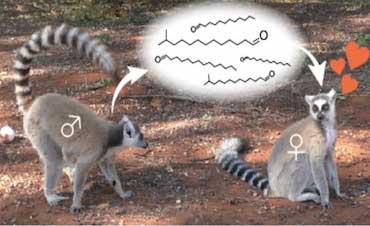



|
TOPICS BONOBO Chimpanzee "Ai" Crania photos Itani Jun'ichiro archives Open datasets for behavioral analysis Guidelines for Care and Use of Nonhuman Primates(pdf) Study material catalogue/database Guideline for field research of non-human primates 2019(pdf) Primate Genome DB 
Primate Research Institute, Kyoto University Copyright (c) |
Japanese
Key Male Glandular Odorants Attracting Female Ring-Tailed Lemurs
Mika Shirasu, Satomi Ito, Akihiro Itoigawa, Isao Munechika, Hiroo Imai, Kazushige Touhara
Summary
Among rodents, information about the external world is mainly acquired via the olfactory system, which is one of five sensory modalities. Several semiochemical signals are used for inter- and intraspecies communication [1]. In contrast, primates are generally regarded as vision-oriented mammals, and have been thought to trade their olfactory sensitivity for good sight. However, strepsirrhines have a well-developed olfactory system [2] and a larger repertoire of functional olfactory and vomeronasal receptor genes than haplorhines [3, 4]. Moreover, strepsirrhines are well known for their use of olfactory communication in social behavior. Ring-tailed lemurs are a species of Malagasy strepsirrhines, and use olfactory cues for conspecific communication. Male lemurs mark their scent by spreading volatiles from the antebrachial gland on their wrists. This study combined ethological and chemical approaches to identify a key odorant(s) in antebrachial secretions involved in the sexual communication of lemurs. The results of a behavioral assay indicated that females sniff the malesăŕ antebrachial secretions longer during the breeding season than during the nonbreeding season. By examining seasonal changes in volatiles using gas chromatography-mass spectrometry, we found that the secretion of three C12 and C14 aldehydes with a fruity and floral scent significantly increased during the breeding season in a testosterone-dependent manner. Females sniffed for longer at biologically relevant concentrations of two of the aldehydes (12-methyltridecanal and tetradecanal) and were attracted to a mixture of these plus the third aldehyde, dodecanal. Our results suggest that these aldehydes are putative lemur pheromones involved in the attractiveness of males to females during the breeding season.  Bibliographic information
Current Biology Published:April 16, 2020 DOI: https://doi.org/10.1016/j.cub.2020.03.037 2020/04/17 Primate Research Institute
|